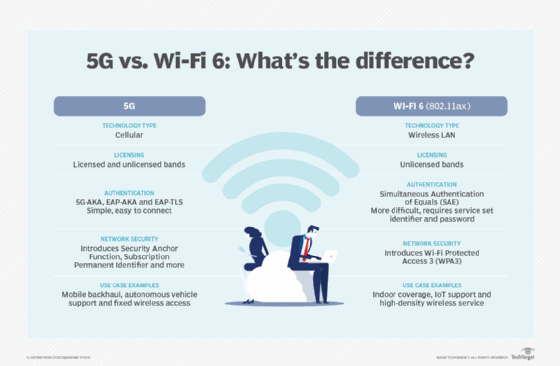
ake78 (3D & photo) - Fotolia
Wi-Fi 6 and 5G for IoT mean fewer barriers to deployment
With Wi-Fi 6 and 5G rolling out, organizations might wonder if the latest generations are worth the investment to improve IoT deployment efficiency.
Neither Wi-Fi 6 nor 5G will revolutionize IoT because most IoT applications won't require them. However, both technologies will erase barriers to IoT deployment in some key areas, and that's an essential step toward creating a truly pervasive IoT future.
The hottest subject in IoT is 5G cellular technology. The majority of IoT devices, however, are on Wi-Fi, and there's a new Wi-Fi technology in the mix, too: Wi-Fi 6. Organization leaders might ask themselves where these two new network technologies fit best, could they be symbiotic, and will other older IoT protocols be killed off by the new choices. Both 5G and Wi-Fi 6 are rolling out now, so it's time to take a closer look at how they could affect IoT, starting with their missions and differences.
5G and Wi-Fi 6 both increase network speeds
5G is the next stage in the evolution of cellular broadband services. It offers higher speeds up to 10 times more than 4G, more devices per cell, lower latency and, most important for IoT, new options for private communications. With 5G, for the first time, a public wireless network can be sliced to create special-purpose networks and even private networks.
In contrast, Wi-Fi 6 is an inherently private-network technology. In terms of capabilities, it's surprisingly similar to 5G in that it increases the top speed by about four times, total data capacity by four times and reduces latency by 75%, according to experts. It's safe to say that every organization has Wi-Fi networks and experience. As Wi-Fi 6 rolls out in new devices, organizations should quickly see mass-market economies for products.

Wi-Fi 6 offers practical IoT use with limitations
If we look at IoT in evolutionary terms, Wi-Fi 6 is the clear winner. Today, the majority of IoT devices connect to Wi-Fi or an IoT-specific protocol designed for local ranges only, because the majority of IoT is deployed within a facility where Wi-Fi coverage is practical. Within large facilities with high device density, a single hub can support more connections and its lower latency can improve the control loop performance of feedback from sensor to response.
Where Wi-Fi 6 starts to show some limitations is in its restricted range per hub. Covering a home or office might require a single hub, but a large factory or warehouse could require a dozen or more. Hubs must run on a single network for delivery to applications. If multiple hubs are needed to cover a whole factory, additional devices are needed, such as routers that aggregate the traffic from each hub. Each device adds latency and can eliminate the Wi-Fi 6 advantage.
Wi-Fi 6 also inherits Wi-Fi's general lack of roaming capability, which has a significant impact on mobile sensor applications. For example, in a large warehouse with automated vehicles moving goods, the vehicles would surely roam through multiple Wi-Fi coverage areas. When one vehicle leaves an area and enters another, the data connection is lost and must be reestablished. It's critical that applications understand the new vehicle that's popping up in one zone is actually the one that left another; otherwise, control continuity is lost.
5G extends coverage for edge sensors
With 5G, IoT users may have three options to improve both mobile-device support and coverage for very large facilities. The most obvious is that a 5G public network can support sensors and controllers anywhere there's cellular coverage, making it the ideal choice for widely spread sensors or sensors on transportation vehicles, whether road, rail or river. A complete 5G deployment -- called 5G Standalone or 5G Core -- will also offer a completely new kind of network: the slice.
With network slicing, a 5G carrier can create an almost private 5G network by partitioning its 5G radio, backhaul, metro and core networks. Users are secured through device authentication, and their traffic is separated and noninterfering. Network slicing is still a new offering, though, so costs and the geographic scope of the slices aren't fully known. But the network slicing capability is likely to be an effective strategy for organizations that have a lot of IoT elements spread widely, many of which are mobile.

5G offers a final option: a fully private 5G network. These networks can be based on either licensed or unlicensed, shared spectrums. The power of the stations and their range will probably vary based on different countries' local regulations, but they're likely to have far greater range than Wi-Fi 6. What makes a fully private 5G network potentially practical is the trend toward open-model 5G networking, from the radio access network inward to the core. It's already possible to build a 5G network from white box hardware and open source software, and it's likely to get easier over time.
How to choose between Wi-Fi 6 and 5G for IoT
Few credible IoT applications will demand the higher per-user bandwidth that either 5G or Wi-Fi 6 offers. The determining factors in deciding between the technologies will come down to availability, range, and the interplay of mobility and roaming capability. It may come down to a simple rule: If you can make your IoT application work with Wi-Fi today, then Wi-Fi 6 will likely make it work a little better. If you can't, then you probably won't be able to use Wi-Fi 6 either.
5G is generally going to be a more expensive choice than Wi-Fi 6. To justify the cost, the organization must have some specific reason why Wi-Fi won't work, such as a large facility or mobile sensors and controllers in use. While 5G costs aren't yet fully stabilized, public 5G is likely to be less expensive than network slices or private 5G, except where very large numbers of IoT devices are involved. For any 5G option, be sure that the service type you want is available wherever you plan to use it.
What to do if neither 5G nor Wi-Fi 6 fit
5G isn't the only option if Wi-Fi and Wi-Fi 6 won't work in your application. There are a variety of IoT protocols already in use, most notably ones like X10 and ZigBee that are based on standards. These protocols are most useful for short-range in-home or in-office use, or within small facilities where multiple hubs can be used to cover a wider area. Their primary advantage compared to Wi-Fi is low cost for support in sensors and controllers. Where that's a factor, neither Wi-Fi 6 nor 5G are likely to offer much improvement.







